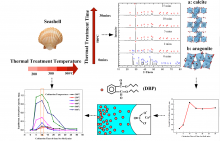
The calcined clam seashell powders were applied as adsorbent to adsorb Dibutyl phthalate (DBP), from an aqueous solution. The influence of calcination conditions including temperature and time on its adsorption capability to DBP was investigated. The shell powders calcined at 500 oC had the best adsorption capability. As the calcination time extending under different temperatures, the adsorption capabilities showed the same tendency and reached peak values at the calcination time of 10mins. Calcination time extension also led to the increase of crystal unit cell Sizes of CaCO3 inside the clam seashells at the first 10mins and then decreased to the stable value, Correspondingly, the calcined shell specific surface areas decreased firstly to the minimum at 10mins and then gradually increased, as the calcination process lasting at 500oC. The maximum adsorption capability as 1.237mg/g, the lowest specific surface area as 14.2m2/g, and the largest unit cell size as 60.7nm of CaCO3 simultaneously exhibited at the calcination time of 10mins. The Freundlich isotherm model and the pseudo-second-order-kinetics model were appropriate for describing the adsorption isotherm and kinetics of DBP at 30oC, respectively. It is inferred that the interaction between calcined shell and DBP is chemical adsorption.
Total file downloads: 4